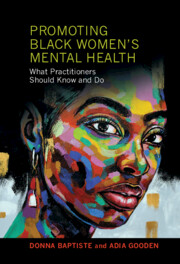Book contents
- Promoting Black Women’s Mental Health
- Promoting Black Women’s Mental Health
- Copyright page
- Contents
- Figures
- Tables
- Contributors
- Introduction
- Part I Black Women in Context
- 1 A Study of Black Women and Psychotherapy
- 2 Social Determinants of Health and Mental Health for Black Women
- 3 Black Girlhood: Developmental Experiences of Black Women
- 4 Stereotypes of Black Women: Clinical Implications
- 5 Black Women and Trauma
- Part II Therapy Contexts
- Part III Core Themes in Black Women’s Stress and Distress
- Part IV Helping Black Women Recover and Thrive
- Appendix
- Index
- References
5 - Black Women and Trauma
from Part I - Black Women in Context
Published online by Cambridge University Press: 22 June 2023
- Promoting Black Women’s Mental Health
- Promoting Black Women’s Mental Health
- Copyright page
- Contents
- Figures
- Tables
- Contributors
- Introduction
- Part I Black Women in Context
- 1 A Study of Black Women and Psychotherapy
- 2 Social Determinants of Health and Mental Health for Black Women
- 3 Black Girlhood: Developmental Experiences of Black Women
- 4 Stereotypes of Black Women: Clinical Implications
- 5 Black Women and Trauma
- Part II Therapy Contexts
- Part III Core Themes in Black Women’s Stress and Distress
- Part IV Helping Black Women Recover and Thrive
- Appendix
- Index
- References
Summary
Given their intersecting, historically oppressed identities, Black women are more likely to be exposed to traumatic experiences than other racial groups. In this chapter we review the historical, systemic and institutional, and individual trauma that impacts the mental health of Black women. We provide a framework for treating trauma with Black women that is based on intersectionality and Black feminist theory. Further, we share the key components of providing trauma-informed care and best practices clinicians can use when supporting Black women in healing from trauma.
Keywords
- Type
- Chapter
- Information
- Promoting Black Women's Mental HealthWhat Practitioners Should Know and Do, pp. 106 - 130Publisher: Cambridge University PressPrint publication year: 2023

